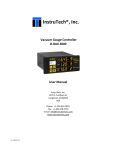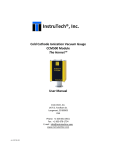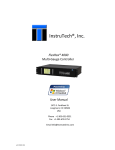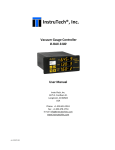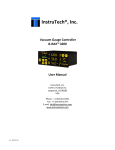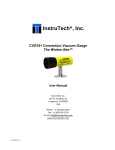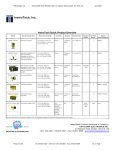Download IGM400 User Manual - InstruTech®, Inc.
Transcript
InstruTech®, Inc. Hot Cathode Ionization Vacuum Gauge IGM400 Module The Hornet™ User Manual InstruTech, Inc. 1475 S. Fordham St. Longmont, CO 80503 USA Phone: +1-303-651-0551 Fax: +1-303-678-1754 E-mail [email protected] www.instrutechinc.com p/n 001792-101 Instruction Manual Important User Information IGM400 Hornet There are operational characteristic differences between solid state equipment and electromechanical equipment. Because of these differences, and because there are a variety of uses for solid state equipment, all persons that apply this equipment must take every precaution and satisfy themselves that the intended application of this equipment is safe and used in an acceptable manner. In no event will InstruTech, Inc. be responsible or liable for indirect or consequential damages that result from the use or application of this equipment. Any examples or diagrams included in this manual are provided solely for illustrative purposes. Because of the many variables and requirements imposed on any particular installation, InstruTech, Inc. cannot assume responsibility or liability for any actual use based on the examples and diagrams. No patent liability is assumed by InstruTech, Inc. with respect to use of information circuits, equipment, or software described in this manual. Throughout this manual we use notes, notices and apply internationally recognized symbols and safety messages to make you aware of safety considerations. Identifies information about practices or circumstances that can cause electrical or physical hazards which, if precautions are not taken, could result in death or serious injury, property damage, or economic loss. CAUTION CccWARNING Identifies information about practices or circumstances that can cause electrical or physical hazards which, if precautions are not taken, could result in minor or moderate injury, property damage, or economic loss. WARNING NOTICE Identifies information that is critical for successful application and understanding of the product. SHOCK HAZARD CccWARNING Labels may be located on or inside the device to alert people that dangerous voltages may be present. WARNING InstruTech, Inc. Page 1 Copyright © 2011 by InstruTech, Inc. All rights reserved. No part of this work may be reproduced or transmitted in any form or by any means, electronic or mechanical, including photocopying and recording, or by any information storage or retrieval system, except as may be expressly permitted in writing by InstruTech, Inc. Printed in the United States of America Swagelok®, Cajon®, VCR® are registered trademarks of the Swagelok Company, Solon, OH. Conflat® is a registered trademark of Varian, Inc. / Agilent Technologies, Lexington, MA p/n 001792-101 Instruction Manual IGM400 Hornet Table of Contents 1 2 3 Introduction / General Information ......................................................................................................3 1.1 Description ....................................................................................................................................3 1.2 Specifications ................................................................................................................................3 1.3 Dimensions ....................................................................................................................................4 1.4 Part Numbers ................................................................................................................................4 Important Safety Information ...............................................................................................................5 2.1 Safety Precautions - General.........................................................................................................5 2.2 Safety Precautions - Service and operation ..................................................................................6 2.3 Electrical Conditions......................................................................................................................7 2.3.1 Proper Equipment Grounding ...............................................................................................7 2.3.2 Electrical Interface and Control .............................................................................................7 2.4 Overpressure and use with hazardous gases ...............................................................................8 2.5 Gases other than Nitrogen / air ....................................................................................................8 Installation ............................................................................................................................................9 3.1 Mechanical Installation .................................................................................................................9 3.2 Electrical Installation ...................................................................................................................10 3.2.1 Grounding ............................................................................................................................10 3.2.2 Electrical connection............................................................................................................10 4 Bakeout ...............................................................................................................................................11 5 Setup and Operation ...........................................................................................................................12 5.1 Emission Current .........................................................................................................................12 5.2 Overpressure shut down.............................................................................................................12 5.3 Degas ...........................................................................................................................................13 5.4 Filament Material Selection / Venting the Chamber ..................................................................13 5.5 Activating the sensor ..................................................................................................................14 5.6 Gauge Status LED ........................................................................................................................14 InstruTech, Inc. Page 1 Instruction Manual 5.7 6 IGM400 Hornet Using the gauge with different gases .........................................................................................15 Service .................................................................................................................................................15 6.1 Calibration ...................................................................................................................................15 6.2 Troubleshooting - Operation ......................................................................................................15 6.3 Troubleshooting - Filaments F1 or F2 open ................................................................................16 6.4 Maintenance ...............................................................................................................................17 6.5 Contamination ............................................................................................................................17 6.6 Sensor Replacement ...................................................................................................................18 7 Factory Service and Support ...............................................................................................................19 8 Warranty .............................................................................................................................................19 InstruTech, Inc. Page 2 Instruction Manual 1 1.1 IGM400 Hornet Introduction / General Information Description A hot cathode ionization gauge measures vacuum pressure by ionizing gas atoms and molecules inside the vacuum region of the gauge transducer and measuring the quantity of ions produced. The measurement of the resulting ion current is directly proportional to the density of gas inside the gauge transducer therefore proportional to the pressure. As pressure inside the vacuum system drops, there are fewer ions created and therefore ion current measured is lower translating to a lower pressure reading. The IGM400 is an ionization gauge module specifically designed for use with InstruTech’s B-RAX™ and FlexRax™ vacuum gauge controllers. The measurement range for the InstruTech IGM400 hot cathode ionization gauge is 1 x 10-9 to 5 x 10-2 Torr. 1.2 Specifications measurement range accuracy - N2 (typical) repeatability - (typical) materials exposed to gases sensitivity x-ray limit emission current degas overpressure protection filament status internal gauge volume operating temperature storage temperature bakeout temperature humidity weight housing (electronics) mounting orientation altitude setpoint relay input signal filament selection input power connector/cabling CE compliance environmental InstruTech, Inc. -9 -2 -9 -2 -7 1 x 10 to 5 x 10 Torr / 1.3 x 10 to 6.7 x 10 mbar / 1.3 x 10 to 6.7 Pa -8 -2 1 x 10 to 5 x 10 Torr; ± 15% of reading ± 5% of reading dual filaments: yttria coated iridium or optional tungsten Ion collector: tungsten Grid: tantalum Others: 316/304 SS, glass, nickel Factory pre-set. Also user adjustable from 2 to 99 (set by the B-RAX or the FlexRax) -10 -10 -8 < 5 x 10 Torr, < 6.7 x 10 mbar, < 6.7 x 10 Pa 100 μA, 4 mA, or automatic switching between 100 μA and 4 mA 3 W, electron bombardment -2 gauge turns off at factory default setting of 5 x 10 Torr B-RAX or FlexRax can also be set up to auto filament turn on/off using a convection gauge filament on/off status LED located on the IGM400. The filament on/off status is also displayed by either the B-RAX or the FlexRax controller 3 3 1.0 in (16.4 cm ) o 0 to + 40 C o -40 to + 70 C o 200 C (sensor only - electronics removed) 0 to 95% RH non-condensing 0.6 lb. (0.27 kg) with NW25 KF flange aluminum extrusion any operating; 8,200 ft. (2,500 m) max storage; 41,000 ft. (12,500 m) max relays available at the B-RAX or the FlexRax all IGM400 operations controlled from the B-RAX or the FlexRax user selectable between filament 1 and 2 - command signal sent from the B-RAX or FlexRax powered by either B-RAX or FlexRax Multi-Gauge Controllers InstruTech custom cable/connector assembly for connection to either B-RAX or FlexRax EMC Directive 2004/108/EC, EN61326-1, EN55011 Low Voltage Directive 2006/95/EC, EN61010-1 RoHS compliant Page 3 Instruction Manual 1.3 IGM400 Hornet Dimensions fitting NW16KF NW25KF NW40KF 1 1/3 in. Mini CF 2 3/4 in. Conflat® 3/4 in. Tube 1/2 in. VCR 1.4 Part Numbers IGM400 Fittings / Flanges With Yttria Filaments NW16KF NW25KF NW40KF 1 1/3 in. Mini-CF/NW16CF Mini-Conflat® 2 3/4 in. CF / NW35CF Conflat® 3/4 in. Tube (3/4 in. O.D. O-ring compression) 1/2 in. Cajon® 8VCR® female IGM400YBX IGM400YCX IGM400YDX IGM400YEX IGM400YFX IGM400YAX IGM400YHX IGM400 / B-RAX , FlexRax cable Cable, IGM400 to B-RAX/FlexRax, 10ft. (3m) Cable, IGM400 to B-RAX/FlexRax, 25ft. (8m) Cable, IGM400 to B-RAX/FlexRax, 50ft. (15m) 1 dimension A 1.45 in. (37mm) 1.45 in. (37mm) 1.45 in. (37mm) 1.85 in. (47 mm) 1.70 in. (43 mm) 2.16 in. (55 mm) 2.58 in. (65 mm) With Tungsten Filaments IGM400TBX IGM400TCX IGM400TDX IGM400TEX IGM400TFX IGM400TAX IGM400THX Replacement Sensor - Yttria Replacement Sensor - Tungsten IG4YB IG4YC IG4YD IG4YE IG4YF IG4YA IG4YH IG4TB IG4TC IG4TD IG4TE IG4TF IG4TA IG4TH InstruTech Part Number 1 BXC400-1-10F BXC400-1-25F BXC400-1-50F BXC400-1- type cables are compatible with both IGM400 and CCM500 Hornet devices. InstruTech, Inc. Page 4 Instruction Manual 2 IGM400 Hornet Important Safety Information InstruTech has designed and tested this product to provide safe and reliable service, provided it is installed and operated within the strict safety guidelines provided in this manual. Please read and follow all warnings and instructions. WARNING WARNING To avoid serious injury or death, follow the safety information in this document. Failure to comply with these WARNING safety procedures could result in serious bodily harm, including death, and or property damage. Failure to comply with these warnings violates the safety standards of installation and intended use of this instrument. InstruTech, Inc. disclaims all liability for the customer’s failure to comply with these instructions. Although every attempt has been made to consider most possible installations, InstruTech cannot anticipate every contingency that arises from various installations, operation, or maintenance of the module. If you have any questions about the safe installation and use of this product, please contact InstruTech. This device meets FCC part 15 requirements for an unintentional radiator, class A. 2.1 Safety Precautions - General Hazardous voltages are present with this product during normal operation. The product should never be operated with the covers removed unless equivalent protection of the operator from accidental contact with hazardous internal voltages is provided. WARNING! There are no operator serviceable parts or adjustments inside the product enclosure; refer servicing to service trained personnel. Do not modify this product or substitute any parts without authorization of qualified InstruTech service trained personnel. Return the product to an InstruTech qualified service and repair center to ensure that all safety features are maintained. Do not use this product if unauthorized modifications have been made. WARNING! Source power must be removed from the product prior to performing any servicing. After servicing this product, ensure that all safety checks are made by a qualified service person. When replacement parts are required, ensure that the parts are specified by InstruTech, Inc. Substitutions of nonqualified parts may result in fire, electric shock or other hazards. Use of unauthorized parts or modifications made to this product will void the warranty. To reduce the risk of fire or electric shock, do not expose this product to rain or moisture. These products are not waterproof and careful attention must be paid to not spill any type of liquid onto these products. Do not use these products if they have been damaged. Immediately contact InstruTech, Inc. to arrange return of the product if it is damaged. InstruTech, Inc. Page 5 Instruction Manual IGM400 Hornet Due to the possibility of corrosion when used in certain environmental conditions, it is possible that the product’s safety could be compromised over time. It is important that the product be periodically inspected for sound electrical connections and equipment grounding. Do not use if the equipment grounding or electrical insulation has been compromised. 2.2 Safety Precautions - Service and operation Ensure the IGM400 is properly connected to earth ground. Do not turn on filaments and try to activate the sensor when pressure exceeds 1.00 x 10-3 Torr if the device is operating at the 4 mA emission current setting. Do not turn on the filaments and try to activate the sensor when pressure exceeds 5.00 x 10-2 Torr if the device is operating at the 100 μA emission current setting. Ensure vacuum level is at or less than 5.00 x 10-5 Torr before attempting to initiate degas. WARNING! The power supply used in the IGM400 hot cathode gauge module is subject to high voltages which could cause severe injury or death. In order to prevent electric shock and bodily harm, the user should wait 5 minutes after power is removed before touching the IGM400 power supply components. WARNING! When the IGM400 is turned on, 180 V is present at the power supply and other components such as the ion gauge and the cable. Furthermore, voltages as high as 350 V are present during degas. DO NOT operate or apply power to the IGM400 with the IGM400 enclosure removed. Contact with exposed electrical circuits in the IGM400 could result in death or serious injury. NOTICE Do not use another gauge to automatically turn off the Ion gauge when the Ion gauge filament in use is constructed of tungsten (yttria coated filament is ok). The response time of other gauges may not allow for timely turn off of the tungsten filament leading to filament damage. Always turn off the IG filament manually before pressure is to rise above 1.00 x 10-3 Torr. When using yttria coated filaments, it is highly recommended to periodically alternate operating Filaments 1 and 2. An inactive filament not operating for an extended length of time may result in that filament failing to establish emission current when it is eventually used. This will be more problematic in dirty applications. The source power to the IGM400 is supplied from the B-RAX or the FlexRax controller using the custom cable provided by InstruTech. Turn off power to the unit before attempting to service the module. Turn off power to the unit before detaching the electronics from the sensor for sensor replacement or bake-out purposes. Turn off power to the unit if a cable or plug is damaged or the product is not operating normally according to this instruction manual. InstruTech, Inc. Page 6 Instruction Manual IGM400 Hornet Do not use if the unit has been dropped or the enclosure has been damaged. Contact InstruTech for return authorization and instructions for returning the product to InstruTech for evaluation. Use yttria coated filaments with air and inert gases such as N2, argon, etc. Optional tungsten filaments are available for use with gases not compatible with yttria filaments. The most common cause of all vacuum gauge failures is contamination of the sensor. Noisy or erratic readings and total gauge failure are possible indications of gauge contamination. Contamination can generally be characterized as either: A) A physical or chemical reaction of process gases with the sensor element. A different gauge may be considered if neither Yttria nor Tungsten filament sensor materials are compatible with your application. B) An accumulation of material on the sensor element. In this case, performing the degas function of the instrument may resolve the issue. 2.3 Electrical Conditions WARNING! When high voltage is present in any vacuum system, a life threatening electrical shock hazard may exist unless all exposed electrical conductors are maintained at earth ground potential. This applies to all products that come in contact with the gas contained in vacuum chambers. An electrical discharge within a gaseous environment may couple dangerous high voltage directly to any ungrounded conductor of electricity. A person could be seriously injured or killed by coming in contact with an exposed, ungrounded electrical conductor at high voltage potential. This condition applies to all products that may come in contact with the gas inside the vacuum chamber (vacuum/pressure containment vessel). 2.3.1 Proper Equipment Grounding WARNING! Hazardous voltages that could seriously injure or cause death are present in many vacuum processes. Verify that the vacuum connection port on which the ion gauge is mounted is electrically grounded. Consult a qualified Electrician if you are in doubt about your equipment grounding. Proper grounding of your equipment is essential for safety as well as intended operation of the equipment. The vacuum gauge transducer and enclosure of any control module must be connected directly to a good quality equipment earthing conductor. Use a ground lug on the vacuum connection flange of the pressure measurement device if necessary. WARNING! In order to protect personnel from electric shock and bodily harm, shield all conductors which are subject to potential high voltage electrical discharges in or around the vacuum system. 2.3.2 Electrical Interface and Control It is the user’s responsibility to ensure that the electrical signals from this product and any connections made to external devices, for example, relays and solenoids, are used in a safe manner. Always double check the system set-up before using any signals to automate your process. Perform a hazardous operation analysis of your InstruTech, Inc. Page 7 Instruction Manual IGM400 Hornet system design and ensure safeguards and personnel safety measures are taken to prevent injury and property damage. 2.4 Overpressure and use with hazardous gases WARNING! Install suitable protective devices that will limit the level of pressure inside your vacuum chamber to less than what the vacuum chamber system components are capable of withstanding. In cases where an equipment failure could cause a hazardous condition, always implement fail-safe system operation. For example, use a pressure relief device in an automatic backfill operation where a malfunction could result in high internal pressures if the pressure relief device was not installed on the chamber. The IGM400 is not intended for use at pressures above 20 psia (1000 Torr); DO NOT exceed 35 psig (< 2 ½ bars) pressure inside the sensor. If your chamber goes to higher pressures, you should install an isolation valve or pressure relief device to protect the gauge tube from overpressure conditions. With some fittings, actual safe overpressure conditions may be lower; for example, a quick-connect, O-ring compression fitting may forcibly release the gauge tube from the vacuum chamber fitting with only a few psi over local uncorrected barometric (atmospheric) pressure. CAUTION! If the internal pressure of a vacuum gauge device is allowed to increase above local uncorrected barometric pressure (atmospheric pressure side), vacuum fittings may release and possible overpressure conditions may cause leaks that would allow the gas inside the gauge tube to release into the atmosphere of the surrounding environment. Toxic, pyrophoric and flammable gases are examples of hazardous gases that if allowed to leak out of the vacuum/pressure containment vessel into the atmospheric environment, could cause bodily injury and possible damage to equipment. Never expose the gauge tube internal volume to pressure above local atmospheric pressure when using hazardous gases. 2.5 Gases other than Nitrogen / air WARNING! Do not attempt to use with gases other than nitrogen (N2) or air without referring to correction factor data tables. InstruTech gauges are calibrated for direct readout of nitrogen or air. Do not attempt to use with other gases such as argon (Ar) or carbon dioxide (CO2) unless accurate conversion data for N2 to other gas is properly used. Refer to the correction factor data listed in the controller User Manual operating this device. The InstruTech B-RAX or the FlexRax controller User Manuals provides a more complete discussion of using correction factors when using the gauge on gases other than N2 / air. WARNING! Do not use this device in an explosive atmosphere or in the presence of flammable gases, vapors or fumes. Do not use this device to measure the pressure of explosive or combustible gases or gas mixtures. The sensor filaments operate at incandescent temperatures and could become an ignition source. This could cause an explosion which could result in serious injury or death. InstruTech, Inc. Page 8 Instruction Manual 3 3.1 IGM400 Hornet Installation Mechanical Installation Mount the IGM400 as close as possible to the pressure you want to measure. Long or restricted, small diameter tubing will create a pressure difference between your process chamber and the gauge. This may cause a delay in response to pressure changes. Mounting the IGM400 too close to a gas source inlet may also cause measurement and control instability. The IGM400 can be mounted in any orientation, however, if possible, mount the gauge with port down to help minimize the effect of any particles or condensation collecting in the gauge. Do not mount the IGM400 where it will be subjected to excessive vibration. Vibrations may cause unstable readings, measurement errors and possible mechanical stress to components in the IGM400. Shield the IGM400 near ion or electron sources such as an electron beam or in a sputtering system. For electrical safety purposes the housing of the gauge must be grounded to the vacuum chamber. When using KF flanges, metal clamps must be used to ensure proper grounding. Do not attempt to modify your flange in order to use non-metallic-type flange clamps. Fittings/Flanges - follow the fitting/flange manufacturer's recommendations for installation and use. Use all metal vacuum fittings with metal seals when operating pressures are expected to be below 1.00 x 10-7 Torr (1.33 x 10-7 mbar, 1.33 x 10-5 Pa). InstruTech, Inc. Page 9 Instruction Manual 3.2 IGM400 Hornet Electrical Installation 3.2.1 Grounding Be sure the vacuum gauge and the rest of your vacuum system are properly grounded to protect personnel from shock and injury. Be aware that some vacuum fittings, especially those with O-rings when not used with metal clamps, may not produce a good electrical connection between the gauge and the chamber it is connected to. Use a ground lug on the vacuum connection flange of the pressure measurement device if necessary. 3.2.2 Electrical connection Use the InstruTech custom cable/connector assembly for connection to B-RAX or the FlexRax vacuum gauge controller. Gauge Status LED green = filament on blank = filament off flashing = error IGM400 connector CAUTION! Possible damage to property and injury to personnel may result if connections to the Ion Gauge (IG) connector of the IGM400 are made while power is applied to the controller unit. DO NOT connect, disconnect or reconnect the cable from the controller back panel IG connector to the IGM400 module when power is applied to the controller. Switch the AC Mains Power Switch on the back panel of either the B-RAX or the FlexRax controller to OFF (0) prior to either disconnecting or reconnecting cables to the IGM400 module. The DE-9P D-subminiature end of the InstruTech cable assembly for connecting the IGM400 ion gauge module to either the B-RAX or FlexRax is connected to the IGM400 module. The mini-DIN connector end of this cable connects to the connector labeled IG on the back panel of the B-RAX or to the connector labeled IG on one of the available IGM/CG option cards in the FlexRax. InstruTech, Inc. Page 10 Instruction Manual 4 IGM400 Hornet Bakeout If desired, a chamber bake may be performed for new systems or after routine maintenance. The IGM400 sensor can be baked out to 200 oC as long as the sensor fitting uses metal seals. For sensor fittings using elastomer O-rings, the maximum bakeout temperature is limited to the maximum temperature rating of the elastomer O-ring. Ensure the temperature of the sensor tube and the vacuum fitting to the sensor is at the same or above the chamber temperature. The electronic module must be removed from the sensor if the bakeout temperature is to exceed 70 oC. To bake out the sensor use the following procedure: 1. Turn off power to the IGM400. 2. Disconnect the cable from the IGM400. 3. Use a 3/32 in. size Hex key to remove the #4-40 socket head cap screws (SHCS) as shown below. 4. Detach the metal enclosure and the electronics from the sensor. Gently pull the electronics enclosure away from the sensor using a gentle rocking motion. 5. The black plastic cap attached to the sensor and the end plate does not have to be removed for bakeout. 6. Perform bake out with the electronics removed. 7. Reattach the electronics enclosure. Reinstall the 4-40 SHCS (4 ea). InstruTech, Inc. Page 11 Instruction Manual 5 IGM400 Hornet Setup and Operation The IGM400 receives power from the B-RAX or the FlexRax controller via custom cables supplied by InstruTech. All display and control functions of the IGM400 are performed remotely by the B-RAX or the FlexRax controller. The IGM400 receives commands for the emission current selection; degas function commands as described below and all other control functions from the B-RAX or the FlexRax controller. 5.1 Emission Current 4 mA or 100 µA (0.1 mA) emission current are available settings of emission current. 1) In clean applications and operating at higher pressure ranges (5.00 x 10-6 Torr to 5.00 x 10-2 Torr) the 100 µA emission setting is preferred. 2) At lower operating pressures (1.00 x 10-9 Torr to 5.00 x 10-4 Torr) the 4 mA emission setting should be used. 3) The emission current can also be set to automatically switch between 4 mA and 100 µA. This results in optimal and stable pressure readings over the entire measurement range from low to high vacuum. For example if an application requires that pressure measurements be performed by the ion gauge from pressures lower than 5.00 x 10-6 Torr to 5.00 x 10-2 Torr then the user may want to consider using the automatic switching feature of B-RAX or FlexRax controller. The switching of the emission current may be programmed to take place at any pressure from 1.00 x 10-6 to 1.00 x 10-4 Torr. 4) When using a diffusion pump or other pumps that use fluids, there is a possibility of the pump oil vapors entering the IG transducer. These vapors may form an insulator on the internal components of the transducer which can lead to instability or failure in controlling the emission. In this case, the 4 mA emission current may provide improved operating lifetime and measurement performance. 5.2 Overpressure shut down The IGM400 is provided with factory set default values for overpressure shut down. The gauge will shut off automatically should the pressure reach or rise above the pressure shut down values shown below: Emission Current 4 mA 100 µA (0.1 mA) InstruTech, Inc. Factory set overpressure shut down values Overpressure Shut Overpressure Shut Overpressure Shut Down (Torr) Down (mbar) Down (Pa) -3 -3 1.00 x 10 1.33 x 10 1.33 x 10-1 5.00 x 10-2 6.66 x 10-2 6.66 Page 12 Instruction Manual 5.3 IGM400 Hornet Degas Degas is used to rid the gauge sensor of adsorbed gas. Degas is achieved by applying Electron Bombardment (EB) to the grid. The intervals at which degas should be applied vary for each application. The low pressure measurement performance of the transducer will normally improve after each degassing cycle. 5.4 Degas can only be applied while the filament is turned on and operating. Ensure vacuum level is at or less than 5.00 x 10-5 Torr before attempting to initiate degas. Power during degas is about 3 watts higher than the normal operating power. Degas will automatically turn off after 2 minutes when using factory default settings. Degas can be programmed in the B-RAX or FlexRax controller for duration of 2 to 10 minutes. The IGM400 will continue to measure pressure while degas is in progress. Degas will automatically turn off if the pressure exceeds 3.00 x 10-4 Torr during the degas cycle. Degas can be interrupted by turning the IG filament off from the B-RAX or FlexRax controller. Filament Material Selection / Venting the Chamber The choice of which filament material type to use in the IGM400 is primarily dependent upon the process and process gases the ion gauge will be used with. For general vacuum applications, dual yttria coated filaments are offered for use with air and inert gases such as N2, argon, etc. Optional dual tungsten filaments are available for use with gases not compatible with yttria filaments. 1) Yttria coated iridium filament In most general vacuum applications, the yttria coated iridium filament is the best choice. Yttria coated filaments typically operate at a lower temperature than tungsten filaments and thus have a lower outgassing rate at UHV and lower chemical reactivity with active gases. Yttria coated filaments typically have a longer operating life than tungsten filaments in clean applications. The yttria coated filament can survive occasional accidental start attempts at atmosphere in air, but the overall life of the filament may be shortened during each occurrence. Good vacuum practice is to use the CVG101 Worker Bee™ convection gauge to know when to turn on the ion gauge filament. Refer to the vacuum gauge controller operating this device for further details on how to use the convection gauge to turn on the ion gauge filament. InstruTech, Inc. Page 13 Instruction Manual IGM400 Hornet 2) Tungsten filament Typically a bare tungsten filament is a better choice in those applications where an yttria coated filament is quickly damaged due to the gas type in use. For example, processes such as ion implantation may only use tungsten filaments. Be aware that corrosive applications are hard on any filament and filament life will be shortened while operating in such environments. Tungsten filaments are easily damaged by exposure to air/oxygen during accidental system vents or if considerable quantities of water vapor are outgassed during pump-down and bake-out. It is very important to make sure the tungsten filament is turned off before bringing the chamber up to atmosphere, especially if air is being used to vent the chamber. The use of pure N2 gas is highly recommended to vent or purge your vacuum chamber. Testing has shown that tungsten filaments can withstand limited high pressure excursions when only N2 is present. Venting with air or other oxygen containing gases can damage the tungsten filaments. If you try to turn on an ion gauge with tungsten filaments while it is sitting on your desk exposed to room air, you will immediately damage or destroy the filament beyond repair. NOTICE Do not use another gauge to automatically turn off the ion gauge when the ion gauge filament in use is constructed of tungsten (yttria coated filament is ok). The response time of other gauges may not allow for timely turn off of the tungsten filament leading to filament damage. Always turn off the IG filament manually before pressure is to rise above 1.00 x 10-3 Torr. Both types of filaments discussed here will suffer eventual damage if operated at high pressures. The type and amount of damage at high pressure is dependent upon the length of operating time, the pressure and the gases present. 5.5 Activating the sensor Before you turn on the IG filament and activate the sensor, make sure you understand all instructions and information provided in this user manual. You can only activate the sensor from either the B-RAX or the FlexRax controller. Note - It may take up to 8 seconds for the IGM400 transducer filament to turn on after it has received a turn on command from the controller. 5.6 Gauge Status LED The IGM400 is provided with a Gauge Status LED to determine the gauge / filament status as shown in section 3.2.2 and described below: When LED is green = filament on When LED is blank = filament off When LED is flashing = error InstruTech, Inc. Page 14 Instruction Manual 5.7 IGM400 Hornet Using the gauge with different gases InstruTech gauges are calibrated for direct readout of nitrogen or air. Do not attempt to use with other gases such as argon (Ar) or carbon dioxide (CO2) unless accurate conversion data for N2 to other gas is properly used. Refer to the correction factor data listed in the controller User Manual operating this device. The User Manuals for InstruTech’s B-RAX and FlexRax controllers provide a more complete discussion of using correction factors when using the gauge to measure pressure of gases other than nitrogen / air. 6 6.1 Service Calibration Every InstruTech device is calibrated prior to shipment using nitrogen. Care should be exercised when using gases other than nitrogen (N2) / air. (See Section 5.7 titled “Using the gauge with different gases”) 6.2 Troubleshooting - Operation Indication Possible Cause Possible Solution Measurements appear different from expected pressure Sensor not in the proper location to measure system pressure Ensure the sensor is located in appropriate location The process gas is different from the gas (nitrogen) used to calibrate the IGM400 Apply gas sensitivity correction factor if applicable Sensor has been dropped causing mechanical damage Replace the Ion gauge sensor tube The gauge sensor tube is contaminated Replace sensor Leak in the vacuum system Re-check for leak in the system Pressure exceeds 1.00 x 10-3 Torr at Decrease pressure below required value Ion gauge cannot be turned on 4 mA emission Pressure exceeds 5.0 x 10-2 Torr at 0.10 mA (100 µA) emission Decrease pressure below required value Emission Control not functioning Switch to the other filament Replace Ion gauge sensor tube due to possible filament failure or contamination Unable to initiate degas InstruTech, Inc. -5 System pressure above 5.0 x 10 Torr Decrease pressure below the required value Page 15 Instruction Manual 6.3 IGM400 Hornet Troubleshooting - Filaments F1 or F2 open If a filament is open, then trying to start the filament will result in B-RAX or FlexRax error messages “F1 or F2 open” or similar displayed error messages. This may be an indication of open filaments but in some cases it could also be an indication of faulty electronics. To determine whether the problem is caused by either a failed filament or the electronics, refer to section 6.6 and follow instructions to remove the ion gauge transducer from the control module. Measure the resistance (electrical continuity) of filaments 1 and 2 as shown below. A good, intact filament will indicate a resistance of 0.2 ohms on your ohmmeter. InstruTech, Inc. Page 16 Instruction Manual 6.4 IGM400 Hornet Maintenance In general, maintenance is not required for your InstruTech module. Periodic performance checks may be done by comparing the gauge to a known reference standard. When using the transducer in gases containing contaminants or materials that react with the filaments of the hot cathode ion gauge, periodic degas and switching to the alternate filament from time-to-time is recommended for longest useable transducer lifetime. When the hot cathode (filament) of the ionization gauge transducer is at or near end-of-life, transducer (sensor) replacement is recommended. 6.5 Contamination The most common cause of all vacuum gauge failures is contamination of the sensor. Noisy or erratic readings, and total gauge failure are all possible indications of gauge contamination. Contamination can be generally characterized as either a reaction of process gases with sensor elements, or an accumulation of material on the sensor elements. Sensors that fail due to chemical reaction are generally not repairable. Sensors that fail due to condensation, coatings, or particles may possibly be restored by performing the degas function. A) Reactive Gases If process gases react with the materials of construction of the sensor, the result is corrosion and disintegration of the sensor over time. For general vacuum applications, dual yttria coated filaments are offered for use with air and inert gases such as N2, argon, etc. Optional dual tungsten filaments are available for use with gases not compatible with yttria coated filaments. B) Oil, Condensation, Coatings, and Particles If the failure is due to an accumulation of material in the gauge, you may be able to rid the gauge sensor of adsorbed gas using the degas function of the device. Oils and hydrocarbons: Exposure of the gauge internal surfaces to oils and hydrocarbons can result in sensor contamination. Some of these types of contamination may possibly be removed by degas. Furthermore, if there is the possibility of oil back streaming from wet vacuum pumps, it is recommended that a filter or trap be installed to prevent contamination of components of your vacuum system. In some vacuum processes, desorbed and sputtered materials from the process may enter vacuum components connected to the process vacuum chamber by line-of-sight transport especially under high vacuum conditions, i.e., in the molecular flow regime. To prevent materials that may be transported via line-of-sight momentum from entering your vacuum gauge or other components, it is advisable to install some form of apparatus that will block the line-of-sight. In some cases a simple 90o elbow may help prevent or reduce the transport of particles from entering your vacuum gauge. In the event of gauge contamination you can attempt to degas the sensor. If degas fails to resolve the issue, switch to second filament or replace the sensor as described in the next section. InstruTech, Inc. Page 17 Instruction Manual 6.6 IGM400 Hornet Sensor Replacement The IGM400 ion gauge module is factory calibrated for the specific ion gauge transducer (sensor) installed in it. If both filaments fail for any reason, the sensor can be replaced with a new one. The sensitivity of the new sensor must be re-programmed in the external vacuum gauge controller used with the device. Follow all instructions below in order to replace the sensor in the field. If you prefer, you can contact the factory for return authorization and the replacement of the sensor will be done at the factory. To replace the sensor use the following procedure: 1. Turn off power to the IGM400. 2. Disconnect the cable from the IGM400. 3. Remove the IGM400 from the vacuum system. 4. Use a 3/32 in. size Hex key to remove the #4-40 socket head cap screws (SHCS) as shown below. 5. Detach the metal enclosure and the electronics from the sensor. Gently pull the electronics enclosure away from the sensor using a gentle rocking motion. 6. Replace sensor. Reinstall the 4-40 SHCS (4 ea). 7. Reprogram new sensor sensitivity. The sensitivity is a value designated by the letter “S” and marked on the sensor End Plate. InstruTech, Inc. Page 18 Instruction Manual 7 IGM400 Hornet Factory Service and Support If you need help setting up, operating, troubleshooting, or obtaining a return materials authorization number (RMA number) to return the module for diagnosis, please contact us during normal business hours (8:00am to 5:00pm Mountain time) Monday through Friday, at 303-651-0551. Or e-mail us at [email protected]. For the safety of our employees, you must down load a material disclosure form from our website at www.instrutechinc.com Please use this form to provide a history of the gauge detailing what gases have been used. We cannot work on gauges that have been exposed to hazardous materials. 8 Warranty SELLER warrants that its products are free of defects in workmanship and material and fit for the uses set forth in SELLER's catalog or product specifications, under the normal use and service for which they are intended. The entire warranty obligation of SELLER is for the repair or replacement, at SELLER's option, of products or parts (examination of which shall disclose to SELLER's satisfaction that it is defective) returned, to SELLER's plant, properly identified within eighteen (18) months after the date of shipment from InstruTech Plant. BUYER must obtain the approval of SELLER and a return authorization number prior to shipment. Alteration or removal of serial numbers or other identification marks renders this warranty void. The warranty does not apply to products or components which have been abused, altered, operated outside of the environmental specifications of the product, improperly handled or installed, or units which have not been operated in accordance with SELLER's instructions. Furthermore the warranty does not apply to products that have been contaminated, or when the product or part is damaged during the warranty period due to causes other than ordinary wear and tear to the product including, but not limited to, accidents, transportation, neglect, misuse, use of the product for any purpose other than that for which it was designed. THIS WARRANTY IS EXCLUSIVE AND IN LIEU OF ALL OTHER WARRANTIES, EXPRESS OR IMPLIED, INCLUDING ANY IMPLIED WARRANTY OF MERCHANTABILITY OR FITNESS FOR A PARTICULAR PURPOSE. THIS WARRANTY EXTENDS ONLY IN FAVOR OF THE ORIGINAL BUYER. THE BUYER'S SOLE REMEDY SHALL BE THE REPAIR OR REPLACEMENT, AS IS EXPRESSLY PROVIDED HEREIN, OF ANY WARRANTED DEFECTIVE PRODUCT OR PART, AND UNDER NO CIRCUMSTANCE SHALL SELLER BE LIABLE TO BUYER OR ANYONE ELSE FOR ANY CONSEQUENTIAL DAMAGES TO PERSONS OR PROPERTY, FOR INCIDENTAL DAMAGES OR LOSS OF TIME, FOR ANTICIPATED OR LOST PROFITS, OR ANY OTHER LOSS INCURRED BY THE BUYER RELATED TO THE PRODUCT COVERED BY THIS WARRANTY. THIS EXCLUSIVE REMEDY SHALL NOT BE DEEMED TO HAVE FAILED OF ITS ESSENTIAL PURPOSE SO LONG AS SELLER IS WILLING AND ABLE TO REPAIR OR REPLACE DEFECTIVE PARTS IN THE PRESCRIBED MANNER. THIS LIMITED WARRANTY MAY NOT BE MODIFIED BY SELLER UNLESS SUCH MODIFICATION OR WAIVER IS IN WRITING, EXECUTED BY AN AUTHORIZED OFFICER OF SELLER. InstruTech, Inc. Page 19 Instruction Manual InstruTech, Inc. IGM400 Hornet Page 20 InstruTech®, Inc. 1475 S. Fordham St. Longmont, CO 80503 USA Phone +1-303-651-0551 Fax +1-303-678-1754 E-mail [email protected] www.instrutechinc.com p/n 001792-101



























